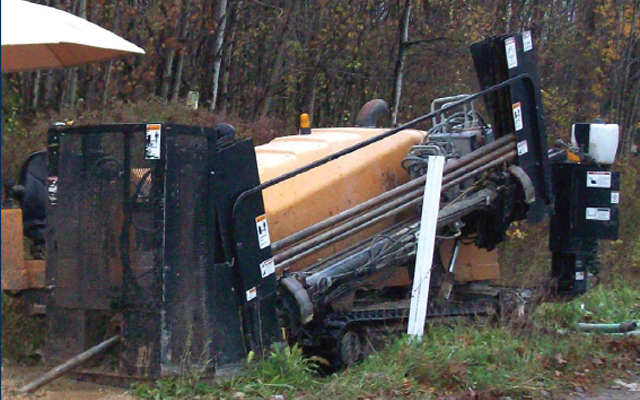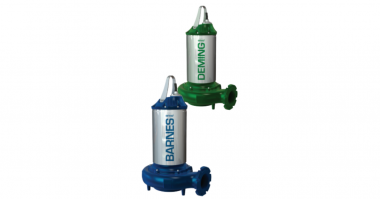Gravity sewer systems have been used since ancient times. They’re…well, ancient technology that involves digging wide, downward-sloping trenches – which is okay for going downhill, but it’s challenging when the terrain is uncooperative. The deeper you go, the more it costs to dig. In addition, you have to periodically raise the sewage along the way with lift stations to keep the gravity flow going. So it’s even harder if you’re going uphill (i.e. it takes more lift stations). It’s also more costly when digging through rocky or sandy soil and traveling over long distances.
Rather than gravity, the pressure sewer system defies gravity using submersible grinder pumps to grind sewage into a slurry and transport it more easily through the system. It uses smaller diameter pipes that are less expensive and easier to install. Plus they follow the terrain, requiring a depth just below the frost line, and move directionally to skirt obstructions.
Significant Cost Difference
Pressure sewer systems have a significantly lower cost of installation compared to traditional gravity systems. Developers must install water, sewer and utilities well in advance of any new home construction. It’s a large capital expense with a long payback cycle. Time is money. It especially squeezes cash flow with a slow build-out rate. This is where a pressure sewer system gives you a financial boost.
The comparatively low up front cost of a pressure sewer system forcemain versus a traditional gravity main represents a true cost savings. This combined with the deferred installation and cost of the grinder pump station to just prior to closing reduces cash outlay. So the time between your expense and funds from the house sale closing is greatly reduced.
Not only does the pressure sewer system cost less to install, but the cost savings grow proportionately as the number and size of lots increases. Since it’s built for durability, it performs efficiently and with very little maintenance for years.
Increased Flexibility
Modern homeowners want options. They build lakeside cottages, homes nestled into hillsides, and secluded getaways. It requires a level of flexibility that traditional, gravity sewer systems can’t provide. On the other hand, a pressure sewer system can travel long distances at a fraction of the cost of a gravity system, hugs the terrain, and can move up, down, and sideways; so it’s a better solution when it comes to many unique site challenges.
Replacing septic systems: When a worn out septic system is at the end its useful life, a pressure sewer system will provide a cost effective method to connect to a municipal system.
High Ground Water: Both the construction and operation of a gravity sewer system are more costly under this condition. Furthermore, the potential infiltration of ground water into the system is a contamination risk. The extra burden can overload treatment plants.
Lakeside or Ocean Front: A residence next to water is a prime location, but the sandy, downward-sloping terrain makes trenching for gravity systems difficult and expensive. Septic systems are a popular second choice, but they pose an environmental and health threat. A pressure sewer system offers a safe, secure alternative.
Surmounting Barriers: Roads and streams that separate lots from an existing sewer system are no problem for pressure sewer systems. Directional boring of the small diameter piping can greatly reduce the need for road repairs and traffic disruptions.
Homes and Gravity Systems that don’t match: When new homes added to a development are too low for basement sewer connections, a grinder pump and pressure sewer line is a simple solution for connecting to the nearest gravity main.
Pressure Sewer Systems Protect the Environment
Gravity sewers are open systems. So after heavy storms, an excess inflow of water increases the risk of spillage contaminating the environment, and can also overwork treatment plants. Pressurized systems are sealed so they prevent infiltration and excess plant inflow. Since treatment plants don’t have to deal with excess water, they can be built smaller for improved economy.
Septic systems are another potential hazard to the environment. Especially as they age, these systems leak and contaminate ground water, streams, and lakes. In fact, according to the EPA, around 10% of the current septic systems fail each year. Considering the US Public Health Service estimates that over 50% of available land in the US is unsuitable for septic tanks, a pressure sewer system is a safe, reliable and cost-effective alternative.
Visit Crane Pumps & Systems at the Pacific Coast Builders Show in San Diego, CA on June 28th & 29th at Booth 2339 and speak to one of our Pressure Sewer Specialists about our Barnes Pressure Sewer Systems.
 Are Gravity Sewer Systems Holding You Down? Download this whitepaper to learn more about pressure sewer systems.
Are Gravity Sewer Systems Holding You Down? Download this whitepaper to learn more about pressure sewer systems.





I didn’t know that sewer systems used lift stations to lift the sewage along the terrain. That is really interesting that some systems don’t use gravity, like the lift stations, and instead grind everything into a slurry to transport everything. I know we had some repair work down in the city’s sewers a while ago. I wonder what kind of system they use.
It helped when you mentioned how pressure sewer washing costs less than gravity systems. It is important to understand that learning as much as you can about your sewer can help you find the best one for your needs. Personally, I would want to get a professional that knows how to care for a septic system, so I’m glad I found your page.